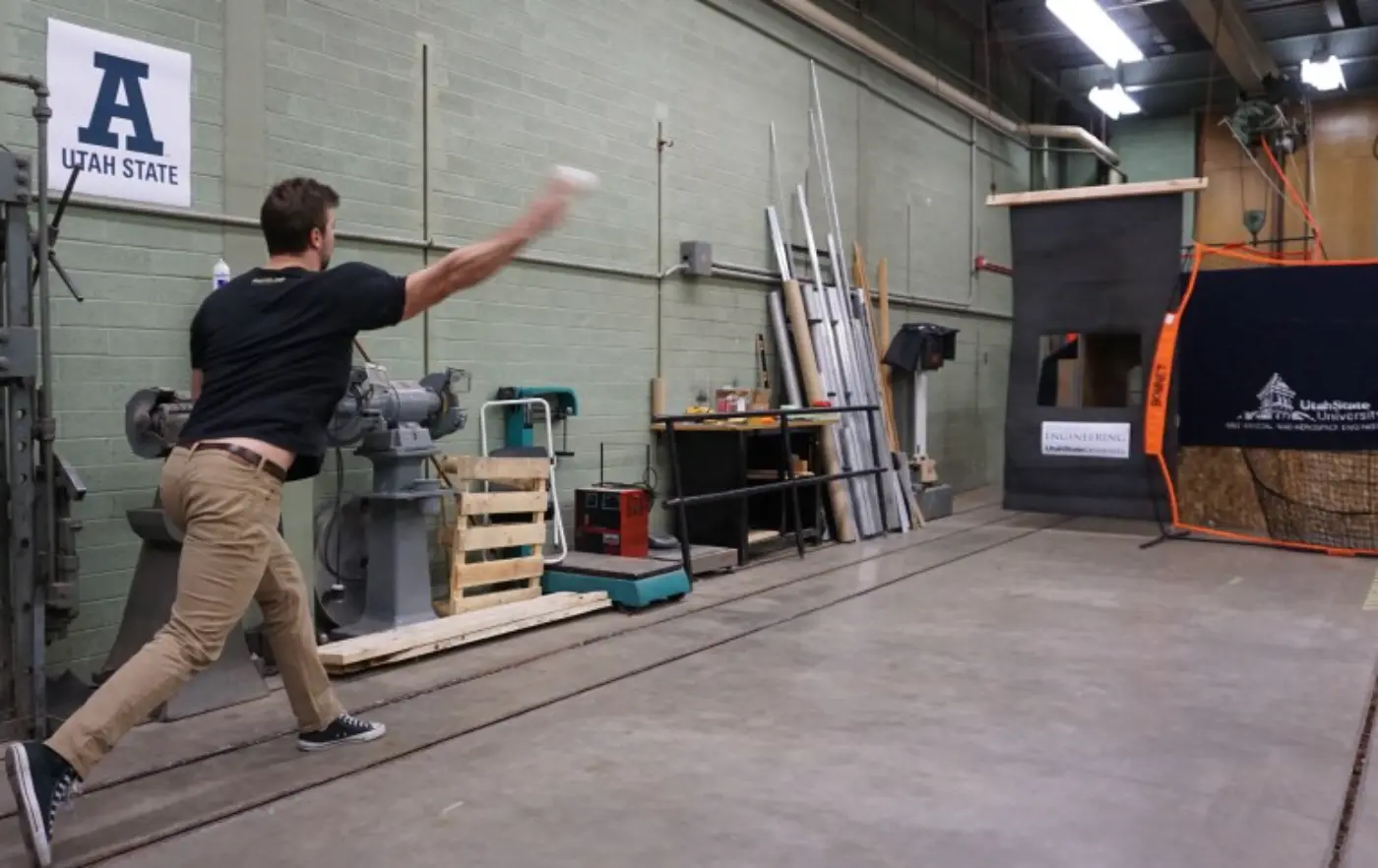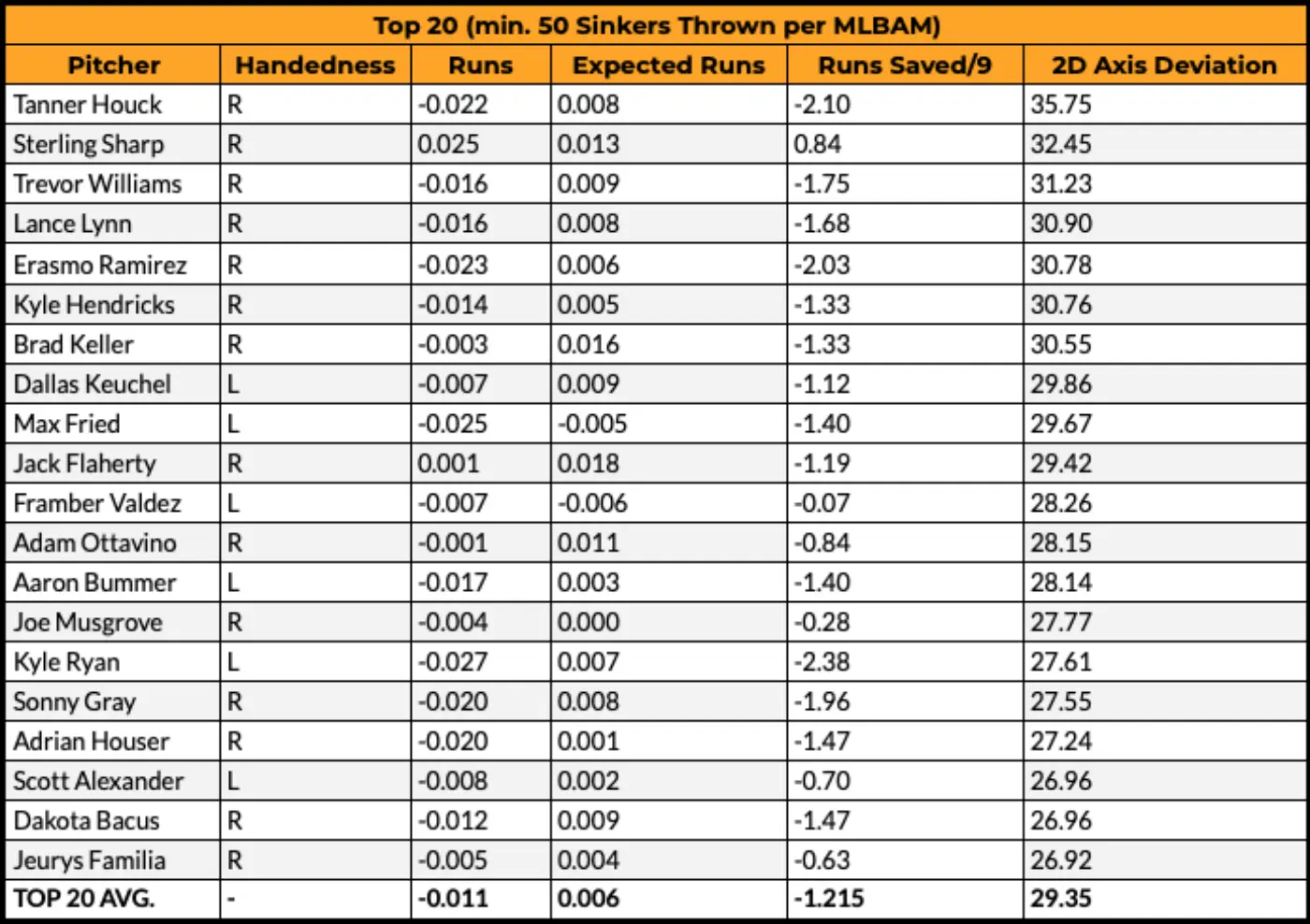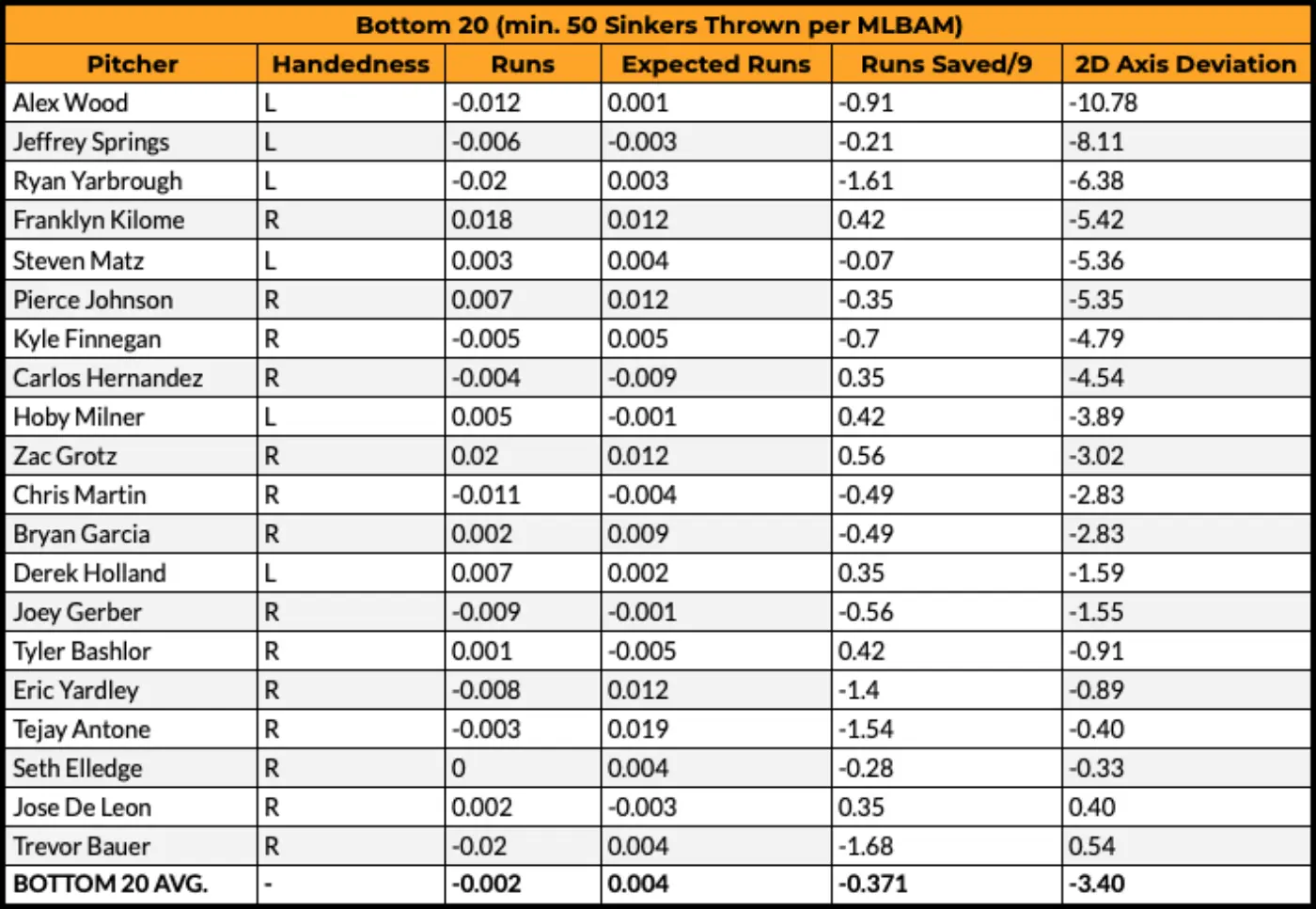An Introduction to Seam-Shifted Wakes and their Effect on Sinkers

Chances are that if you’re reading this blog post, you’ve had the fortune of watching a Mariano Rivera cutter, a Roy Halladay sinker, or a Pedro Martinez changeup – generational pitches that seemingly defied the naked eye as they approached home plate.
Beyond having elite movement profiles, the three pitches above are probably best known for possessing “late” movement– the label often used by scouts, coaches, and players to describe pitches that seemingly change direction just before crossing home plate.
If you talk to most scouts who have racked up countless innings behind home, they’ll often tell you that this late, darting movement is a prerequisite to a plus pitch. Not only do scouts believe late movement on a pitch exists – it’s often what they look for when evaluating a given pitcher.
However, if you talk to most physicists, they’ll tell you that late movement is nothing more than an optical illusion – a function of Newton’s Second Law that deceives us into thinking a new force has been imparted on the ball mid-flight when, in fact, a pitch was moving exactly how we’d expect it to given the spin, release point, and velocity parameters of the pitch itself at ball release.
With such a gap between experiential and theoretical knowledge, what gives? Are there other forces in play that affect ball movement and have gone unnoticed after all these years? If so, are these forces significant, trainable, and noteworthy – or are we just getting caught up in an optical illusion?
INTRODUCING SEAM-SHIFTED WAKES
Prior to the 2020 season, no large-scale evidence had really been found to support either side of the theoretical “unexpected break” debate, as no pitch-tracking technology had been able to reliably compare how a pitch should move (given it’s spin and velocity parameters at release) with how it actually moved during its full trajectory.
Enter Hawk-Eye, the new tracking system of choice for MLB in 2020, which finally gives us access to enough data points to help answer the question of whether pitches can change their shape on the path to home plate.
When we compare projected and actual movement against one another, we get some wild results that have the potential to change pitch design, arsenal optimization, and perhaps pitch evaluation as we know it. Here, we will be taking a deep dive on this effect, otherwise known as the Seam-Shifted Wake Effect, and how it interacts with a pitch that has faded out of the baseball landscape: the sinker.
WHAT IS A SEAM-SHIFTED WAKE?
MAGNUS
To fully understand Seam-Shifted Wakes, we have to throw things back to a topic we’ve covered in the past, the Magnus effect (covered in more detail here: Spin Rate Part I, Spin Rate Part II). Most pitch movement is explained by this force, with the movement coming perpendicular to the Spin Axis of a pitch.

For example, for the above right-handed sinker spinning at an axis just higher than 1:30 (233°) at 100% efficiency, we’d expect it to move with just about equal amounts of horizontal break and vertical break (armside run and rise, respectively).
(GIF of Topspinning Cylinder From Wikipedia)
For the object seen above, we can observe that as more topspin is added (like that of a curveball), the airflow that moves towards the top of the object is halted, while the flow on the bottom is deflected upwards. As a result, there is a downward force on the object, reminding us of Newton’s Third Law of Motion (every action has an equal and opposite reaction).
Now, whether you know it or not, you’ve likely seen a very common, real-world example of wake. If you’ve ever observed a duck making its way across a pond, it’s likely that you’ve noticed ripples forming behind it to either side.

(Image of Duck From Reading Weather and Climate Blog)
It’s a silly example, but the image above shows the same phenomenon that happens with any projectile. On either side of the duck (or a projectile), there is flow caused by surface tension, which is likely symmetric in this case (unless the duck has unique features that cause otherwise). In this example, the displaced water behind the duck would be the wake. In the case of a baseball (or the object shown in the GIF), it is instead displaced air.
NON-MAGNUS
What makes a baseball so unique is the presence of seams in conjunction with smooth surfaces on the ball itself, potentially allowing for specific grips of the ball to create different movement profiles.
We can see this happening in the GIF below, where a cricket ball is shown with a rough side and a smooth side. As the ball interacts with the air around it, we can see that the turbulent airflow (shown to the left) sticks to the ball longer than the smooth airflow. This results in a deflection that forces the ball to move to the left (from our perspective). This effect on sports balls (and baseballs) was detailed in this paper by Rod Cross.
(GIF of Laminar Flow From Vertasium)
While the above is certainly applicable to all kinds of sports, it was a splitter thrown by Freddy Garcia in 2011 that really garnered the baseball community’s interest. While most splitters move to the armside with a small amount of backspin, this pitch moved in the opposite direction.
It is well known that throughout baseball’s history, many pitchers have employed “spitballs” or “scuffballs”, which oftentimes resulted in movement profiles that are irregular due to the alterations made to the surface of the baseball.
(The axis of rotation from this pitch suggests spin should deflect the pitch up and in to the batter, rather than down and away.)
In dissecting the above pitch, Alan Nathan was able to determine (using PITCHf/x data) that much of that splitter’s acceleration wasn’t explained by Magnus force, but rather laminar/turbulent airflow (or boundary layer asymmetry).
Dr. Barton Smith and his colleagues at USU have made it their passion to uncover some of the underlying components behind the “Laminar” pitch, publishing their research here, as well as coining the more descriptive term Seam-Shifted Wake in the process.
Their work has pushed the public’s understanding of Seam Shifted Wake pitch to new heights, potentially changing how we view and evaluate pitches for a long time to come.

(An image of Driveline’s visit to the USU Experimental Fluid Dynamics Laboratory in January of 2019. From left to right: Dean Jackson, Kyle Boddy, Barton Smith, Nazmus Sakib, Eric Jagers and Joe Marsh.)
With all this history in mind, the main concept to grasp is that when you break the symmetry of a wake (creating turbulence on one side), you can create force, and thus movement, that isn’t typical. This can be achieved through seam orientation, hence a “Seam-Shifted Wake”.
THE EFFECT ON SINKERS
WHY FOCUS ON SINKERS?
We are choosing to focus on sinkers to get the ball rolling due to a variety of reasons. First, most work on the subject of Seam-Shifted Wakes in baseball has focused on pitches that move armside, primarily sinkers/two-seamers and changeups. This would make a deep dive into sinkers logical, as we can take steps to corroborate already established, public-facing work. Additionally, the effect seems to be the most pronounced amongst sinkers, making them a logical jumping-off point into further study/analysis of SSW.
Second, to properly do a deep dive on breaking balls (especially sliders), we would need access to spin vectors. These are currently not available in public data provided by MLB, so that is a roadblock to a deeper analysis of those pitches. This is due to the fact that for breaking balls (and any pitch with sub 100% efficiency), some amount of gyrospin is converted to transverse spin during ball flight due to the descent and Spin Axis of the ball itself.
For sinkers, because Spin Efficiency is closer to 100% relative to other secondary pitch types, we don’t have to be as concerned about these effects taking place, better isolating the Seam-Shifted Wake effect. Additionally, the conversion of gyro to transverse typically moves pitches to the gloveside, while we’re specifically looking at an arm-side effect here.
SSW AT THE MAJOR LEAGUE LEVEL
Of course, there isn’t a variable that simply comes right out and says “SSW Effect”, so we have to do a touch of work (and make some assumptions) to see if this effect actually is taking place. We chose to imply the existence of a Seam-Shifted Wake for sinkers by comparing the Inferred Spin Axis (or Spin Direction) from movement to the actual Observed Spin Axis values provided by Hawk-Eye. We chose to call this difference (in degrees) “2D Axis Deviation”.
For both righties and lefties, a positive 2D Axis Deviation signifies a case where the movement of a pitch would suggest a more vertical Spin Axis than what Hawk-Eye believes actually occurred at release (controlled for handedness).
For example, if the Inferred Spin Axis for a particular pitch from a righty was 270°, and the Observed value was 250°, that would result in a 2D Axis Deviation of +20°. Pitches with a positive 2D Axis Deviation are moving more to the arm-side and/or down than we’d expect based on their directly Observed Spin Axis, implying the effect of a Seam-Shifted Wake. Pitches with a negative 2D Axis Deviation generate less arm-side and/or sinking movement than we’d expect.

(The above compares Kyle Hendricks’ inferred Tilt (left) to his Observed Tilt (right))
The league average 2D Axis Deviation in 2020 (the only year with Hawk-Eye data) for sinkers was ~17.6°. You can see the full spread in the density plot below.

(Distribution of 2D Axis Deviation for Sinkers thrown during the 2020 Season)
When looking at this effect at the player level, it’s interesting to see several well-known sinkerballers amongst the leaders. Kyle Hendricks and Dallas Keuchel have made careers out of their prolific sinkers, and based on 2020 data, it appears as though those pitches have gained additional movement through a SSW.

(Runs and Expected Runs are scaled on a per-pitch basis, whereas Runs Saved/9 is meant to be a proxy for how many runs that the pitch would outperform expectations by during a 9 inning game.)
In contrast, those in the Bottom 20 are all examples of cases where the pitcher actually generates less traditional two-seam movement on their sinker than their directly Observed Spin Axis would suggest.

(At the player-level, sinkers in 2020 averaged -0.004 Runs, 0.006 Expected Runs, and -0.735 Runs Saved/9)
HOW DO THESE PITCHERS ACHIEVE SSW?
Though it’s a bit of an inexact science, we scoured the internet for any documentation on grips for those pitchers that had the largest 2D Axis Deviations, and what we found was quite interesting.
Out of the Top 20, twelve pitchers were documented in some form of media (articles, video, Twitter) as throwing a variation of a one-seam sinker. While this grip comes in many forms, it primarily involves one or both fingers living on only one seam of the baseball, rather than sitting between or on top of the tracks of the ball.
This is surprising, as before, the poster child of Seam-Shifted Wakes among sinkers/two-seamers was the Laminar Express. And while some pitchers in the Top 20 still throw a variant of that pitch, it appears as though a majority of the other top deviators threw a member of the one-seamer family.
As an example of this, note the Edgertronic footage below of an in-gym athlete that had a >20° 2D Axis Deviation this past season. Despite the axes on his four-seamer and one-seamer having just a ~1° of measured difference at release, the inferred difference between the pitches amounted to nearly 30° during the 2020 season. This SSW effect helped the athlete generate nearly 5 inches of run and 6 inches of drop off of his four-seamer, giving him a unique GB-inducing weapon in his arsenal.
(One-Seamer (Top) is paired with a fourseamer (bottom) from the same athlete. Despite having the same reported axes, both pitches varied significantly from one another in terms of movement)
DOES IT PLAY?
BEATING EXPECTATIONS
By comparing the actual run values of sinkers thrown in 2020 to the run values that we expected based on our arsenal scores, we can get a sense if this additional effect on the baseball adds any in-game value. The following plot tries to describe this relationship.

(Run values at the pitch level for Sinkers during the 2020 Season.)
As we can see, there’s a pretty direct relationship between 2D Axis Deviation and Run Value – Expected Run Value (our arsenal score). This suggests that pitches with a greater SSW effect outperform expectations. But, does this deviation explain anything in regards to just pure runs?
LIMITING RUNS
Controlling for arm angle, velocity, and pitch movement (horizontal and vertical), we found that 2D Axis Deviation does explain some decrease in runs at the pitch-level. Additionally, running the above features through a variable importance algorithm, 2D Axis Deviation consistently ranked ahead of release speed and horizontal break in regards to importance in relation to run value, coming in just behind vertical break.

(Variable Importance (in relation to Runs) at the pitch-level)
Given the abbreviated nature of the 2020 MLB season, we are going off of a limited sample, but at the introductory level, it does appear that Seam-Shifted Wake sinkers beat expectations and the magnitude of the effect itself plays an important role in predicting run values on their own.
CONCLUSION
FUTURE ANALYSES
Though we are just now scratching the surface with sinkers, it’s clear that other pitch types, primarily changeups and sliders, warrant a closer look. If MLB were to release spin vectors publicly, we could directly measure metrics like spin efficiency, spin based movement, and others that are necessary for an in-depth look (especially with sliders).
We are also hoping to conduct further investigation into the one-seam sinker at our facility in an attempt to see if that pitch (or grips/orientations within that family) allow us to “hack” SSW. Our current hypothesis is that sinkers within the one-seamer family, along with Laminar Express-style pitches, are more prone to taking advantage of this effect.
TAKEAWAYS
From a trainer/athlete perspective, the concept of a Seam-Shifted Wake can be summarized with the following: because of how the seams of the baseball interact with the air around the ball during flight, specific orientations of the baseball at release can give an athlete access to movement profiles that normally would only be achievable by shifting their arm slot or Spin Axis drastically.
There is certainly still more work here to be done, but it appears as though Seam-Shifted Wake pitches are real, and quite valuable if you can find the right combination of forces. Being able to validate this effect, bridging the gap between experiential and theoretical knowledge, is massive in understanding how pitches play at the major-league level, and gives credence to all those in the game that have seen this take place with the naked-eye for decades.
Edited By: Dan Aucoin & Alex Caravan – Co-Managers of Baseball Analytics
Comment section
Add a Comment
You must be logged in to post a comment.
Joe Harder -
Is this something a hypothetical 60 year old pitcher could learn to harness before S.F. Giants Fantasy Camp 2022?